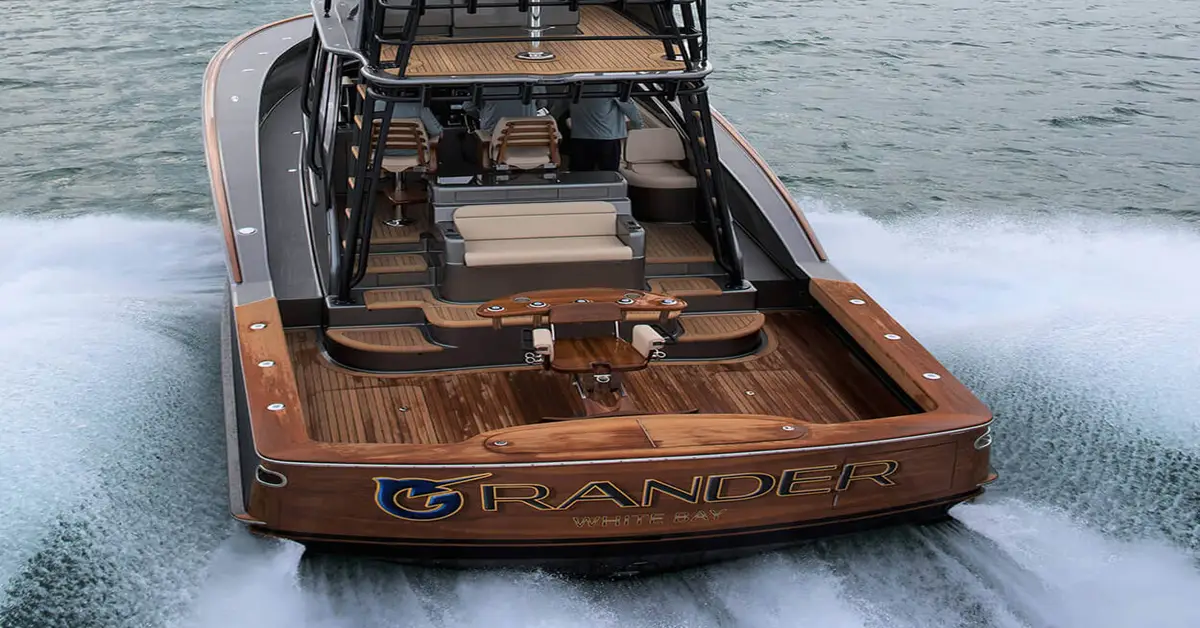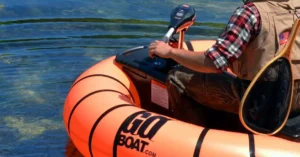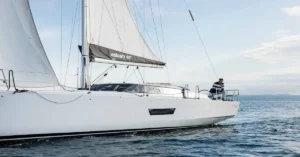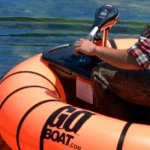The transom of a boat is more than just the stern’s centerpiece; it’s the critical link that ensures a vessel slices through the water with grace and power. Straddling the line between robust engineering and aesthetic charm, the transom’s design is pivotal for optimal maritime performance.
Get ready to dive into boat transoms, where form meets function in the most remarkable ways.
What is the Transom of a Boat?
When I talk about a transom of a Boat, I’m referring to an essential part of the vessel’s design. It’s located at the boat’s stern – the rear end for those unfamiliar with nautical terms. To give you a better picture, imagine the transom as the boat’s backbone at the stern, providing necessary support and shape to the hull as it meets the water.
Key Features of a Boat’s Transom:
- Vertical Structure: A flat, perpendicular surface to the waterline.
- Placement: Positioned at the stern, connecting the starboard and port sides.
- Functionality: Offers structural integrity and supports the engine.
In many powerboats, the transom is where the boat’s engine is mounted, particularly in outboard motor designs. This part of the boat is engineered to handle the weight and vibration of the engine, making it a critical point of strength and stability.
| Aspect | Description |
|---|---|
| Material | Often reinforced with sturdy materials like wood or fiberglass. |
| Purpose | It provides engine attachment points and can serve as a mounting space for equipment like swim platforms or ladders. |
Not every vessel has a traditional transom. Some might have a Euro transom, which integrates a lower section for engine mounting and a separate higher section serving as a bulkhead. This keeps engines apart from the rest of the boat’s spaces.
The health of a boat’s transom is also vital for its longevity. Water damage or rot can compromise its integrity, which is why proper maintenance and care are crucial to ensure a boat remains sea-worthy and safe.
5 Key Facts You Need to Know

When I’m chatting with friends about boating and how to drive a Boat, I love sharing insights about various parts of a boat, especially the transom of a Boat. You might be wondering, what is the transom of a boat and why does it matter?
Here are five key facts I think every boating enthusiast should know:
- The Structural Backbone: The transom is the vertical section at the stern of the boat. It’s crucial because it provides structural integrity, linking the left and right sides of the hull. Think of it as the backbone at the rear end of your boat.
- Engine Mounting: Outboard motors are commonly mounted on the transom. Its strength is essential for supporting the weight and thrust of the engines. Without a sturdy transom, a boat could not efficiently or safely handle the engine’s power.
- Variable Shapes: Although the Transom of a Boat can be flat, its shapes can vary depending on its design and purpose. Some may be curved or follow intricate designs for aesthetic and functional purposes, like improving water flow around the hull.
- Additional Functions: Besides engine support, the transom can mount equipment like swim platforms, ladders, or rudders. This multipurpose feature is integral to the boat’s usability and versatility.
- Maintenance is Key: Like any other part of a boat, the transom requires proper maintenance. It’s exposed to a lot of stress and water, so ensuring it remains sealed and protected from rot or damage is vital for the boat’s longevity.
Remember, a well-cared-for transom contributes significantly to your boat’s performance and safety on the water.
Transom Design and Materials

When I think about a Transom of a Boat it’s not just the flat surface on the stern; it’s a critical component for stability, performance, and the overall aesthetics of the vessel. From the materials chosen to the design, every aspect of a transom matters in delivering the perfect balance and strength.
Different Types of Transoms
I’ve come across several key types of transoms. The traditional flat transom is very common and ideal for mounting motors. Curved and reverse transoms add a modern touch and can improve water flow and aesthetics. With their angled design, Raked transoms offer reduced drag and improved performance.
The cutaway transom eases water flow, while a full transom extends the width of the boat, often incorporating additional features like swim platforms or ladders.
Transom Aesthetics and Design Variations
The transom can significantly influence a boat’s look and feel. Whether it’s a sturdy flat transom on a fishing boat, a sophisticated reverse transom on a yacht, or a practical full transom on a sailboat that houses accessories, each one fuses utility with design.
Even dinghies and canoes with a simple curved transom reflect the thought placed in marrying form with function.
Common Issues and Solutions
A Transom of a Boat can face a variety of issues, especially from rot, cracks, moisture, warping, and water leaks. Regular maintenance, such as inspecting and sealing to maintain structural integrity, is crucial.
For flood or damage control, repairs may involve using marine plywood or fiberglass cloth with resin to restore the transom’s watertight condition. It’s vital to address these problems immediately to prevent compromising the boat design and safety.
Best Practices for Transom Care
Maintaining the structural integrity of a transom requires diligence. I always recommend proper maintenance, including routine inspection and immediate repairs for any signs of wear or damage.
Using quality materials like marine-grade plywood, fiberglass, and resin for any fix ensures longevity. The sealing process can’t be overlooked; the barrier keeps the elements at bay.
In crafting the transom of a boat, a balance between strength, performance, and buoyancy must be struck, all while considering the weight, boat design, and intended accessories to ensure optimal fuel efficiency and reduced drag. With a focus on durability and aesthetics, the right transom can make all the difference.
Transom Functionality and Equipment

When I think about the transom of a boat, I’m reminded of its crucial role in ensuring a vessel performs optimally. It’s not just the rear-most part; it’s a hub for control, power, and functionality.
Transom and Boat Handling
My understanding of a boat’s handling begins with the transom’s ability to affect stability and control. The integration of the transom with the boat’s rudder and stern drive systems is fundamental to navigating through waves and maintaining course in rough waters.
In addition, the transom knees—reinforced structures that connect the transom to the hull—play a significant role in sustaining the boat’s robustness and combating vibrations or listing that could affect the boat’s balance.
Integration with Marine Activities
In terms of boating activities, the transom is where the action is! It’s the mounting point for outboard motors, which provide the torque and thrust necessary for various water sports. The transom saver, a device that supports the weight of the motor when the boat is being transported, helps prevent damage to the transom and increases the longevity of both motor and vessel.
Proper attachment using the right bolts and screws is crucial for safety and performance during any thrilling marine escapade.
Addressing Environmental Impact
As an experienced boater, I’ve learned how vital it is to protect the interior of my boat from the environment. The transom serves as a barrier, preventing water ingress during those moments of cutting through waves or facing rough waters.
Features such as drainage systems are aspects of its design which help manage the challenge of water flow. Nonetheless, signs of damage require prompt repair or replacement to ensure the transom continues providing a reliable defense against the elements.
By maintaining a well-kept and optimized transom, I know I’m investing not only in the safety and performance of my boat but also in an enjoyable and stress-free boating experience.
FAQ – Transom of a Boat

Got questions? Our FAQ section is the go-to spot for clear, concise answers, especially if you’re curious about your target keyword. Dive in and discover the insights you need!
What is the purpose of a transom on a boat?
The transom primarily strengthens your boat’s stern and aft sections. Many modern boat transoms are made of reinforced fiberglass to prevent degradation when exposed to saltwater and other elements and to support the weight of additional items.
Where is the transom located on the boat?
The transom is the flat, vertical structure at the stern or back of the boat. It is typically rectangular and sits at the very end of the boat. While its height can vary, it usually acts as a wall to the back of the boat.
Most motors are attached to the transom, which can make it easy to identify.
What is a transom in marine?
In some boats and ships, a transom is the aft transverse surface of the hull that forms the stern of a vessel. Historically, they are a development from the canoe stern (or “double-ender”), wherein both the bow and stern are pointed.
Be Par of a discussion and drop your anchor in the comments below—share your insights and experiences with the transom of a boat!











